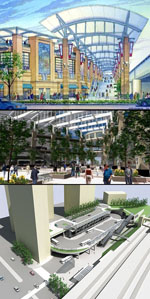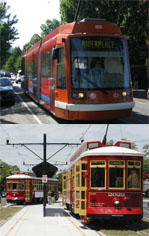It’s unfortunate that our metropolis has reached a stage where a headline like Developer targets middle class is actually news, but here we are, and there it is. Pennrose Properties is constructing 72 rowhouses in Baltimore’s Belair-Edison neighborhood, northeast of downtown, as part of a project that will ultimately include nearly 500 units. Give or take, the new homes will cost about $200, 000, which is just about exactly the current average for a home in Baltimore City.
BeyondDC doesn’t know all the specifics of the deal, so our optimism is a little jaded. Maybe these units will be subsidized by making the other 400 more expensive. Maybe it was required by the City. We don’t know. Further, we’re the first to point out that the current affordable housing crisis is not solely the fault of developers (in fact, we’d rank them way below NIMBYs and counterproductive zoning ordinances on the list of guilty parties). And of course, this is in notoriously inexpensive Baltimore, not Columbia Heights or Dupont Circle. But nevertheless, the proof is here: It is possible for developers to build new housing that’s not marketed for the “luxury” demographic.
Average Rating: 4.4 out of 5 based on 171 user reviews.
July 25th, 2007 | Permalink
Tags: development
|

Top: The original design
Middle: A revised version
Bottom: What was approved
|
Both Union Station and the just approved Silver Spring Transit Center are major multi-modal transportation depots. Both serve Metrorail and MARC, both are major terminals for both local and interstate bus routes, both will soon be served by new light rail lines, and both rank as the largest transportation centers in their respective localities.
But in calling the new Silver Spring depot a “Modern-Day Union Station”, WTOP is forgetting one very important tidbit of information: Whereas Union Station is a grand entry point to Washington and one of the most beautiful and distinguished buildings in a city chock-full of beautiful and distinguished buildings, the Silver Spring depot is an oversized parking ramp. As the images to the right illustrate, what started off as a legitimate modern take on the grand depot has been slowly gutted and is now little more than an above ground version of the long-used and never-enjoyed bus garage that already graces Bethesda.
The approved design may ultimately do the job of getting people where they’re going, but what should have been Silver Spring’s most majestic public space will instead be an eyesore.
How unfortunate.
Average Rating: 4.5 out of 5 based on 271 user reviews.
July 13th, 2007 | Permalink
Tags: architecture, development, transportation
|

Do these look the same to you? Photos from http://world.nycsubway.org |
Back in April, the Examiner’s “Sprawl and Crawl” columnist Steve Eldridge completely mischaracterized Maryland transit. With no doubt the purest of intentions for regional parity in mind, he’s now done it again for the District.
Mr. Eldridge’s recent column regarding Washington’s proposed streetcars is an exercise in inanity. The gist of it is that Eldridge took a trip to New Orleans to check out their heritage trolley operation, found it to be used mostly by tourists, and determined that the DC Circulator already does everything the proposed DC streetcars would do, only better.
Fair enough, but let’s see how he gets there. Point by point:
- “My first impression is that these trolleys take up a very large amount of space. The[y] run down the middle of Canal Street in a space that is wide enough for three or even four vehicular travel lanes.” – Translation: Trolleys will ruin everything for drivers! BeyondDC will ignore the fact that the New Orleans trolleys run down the center of a parkway median that would be that wide regardless of whether it had tracks down the middle of it or not, and simply point out that Mr. Eldridge is welcome to view the plans showing that in no cases will Washington’s streetcars take up so much valuable automobile real estate.
- “Here is a transportation device that more often than not does not have air conditioning… [the passengers] look very much like the passengers on the D.C. Circulator buses but without the added benefit of air conditioning.” – Translation: Trolleys are horribly uncomfortable! Perhaps it is true that the New Orleans streetcars have no A/C, but mentioning that in a discussion about Washington is about as pertinent as mentioning that BeyondDC’s 8-year-old niece likes ponies. Washington will not be using decades-old vehicles without air conditioning. Washington will be using state-of-the-art contemporary vehicles exactly like those currently running in Portland. They very much have air conditioning. This is perhaps the one absolutely sure thing about the DC streetcars, because they’ve already been built! The first batch of Washington’s streetcars are operational and currently undergoing street tests in Europe.
- “The looks on the faces of the passengers as they pass certain buildings and certain sights seem to indicate that these passengers are tourists… the Washington region has accomplished what it set out to do and has in fact replicated the service of the trolley with the DC Circulator.” – Translation: We don’t need trolleys because it’s just for tourists and we already have the Circulator. Perhaps when Mr. Eldridge entertains out-of-town guests he takes them to different places than BeyondDC does. Perhaps Mr. Eldridge’s guests ask to see Barry Farms and the Palace of Wonders. We don’t know. But we do know that DC’s proposed streetcar routes in Anacostia and on H Street do not run through what anyone could reasonably call the tourist heart of the city.
- And finally, on the very last line of the op/ed, Eldridge’s one reasonable question: “The question yet to be answered is whether [serving tourists] is enough and what else a trolley such as the one down here in Na’ Lins can provide.” Well, it’s not exactly a reasonable question, since DC’s streetcars are clearly meant for more than tourists and since they will not be anything like those “down in Na’ Lins”, but we’ll assume good faith and pretend what Eldridge actually means is I wonder what the benefits of streetcars really are. And on this point, we can definitely be of service. Streetcars:
- Have higher capacity than buses. Not only does that mean they can carry more people in real terms, but since one rail vehicle with one driver carries many more people than a bus, and since streetcars can be coupled, the cost to operate per rider is lower for streetcars than buses (assuming adequate ridership).
- Run on electricity rather than oil. Electricity is not only cleaner, but with oil prices continuing to skyrocket, the long term cost savings are potentially enormous.
- Have a better image. Many middle class Americans look down on buses as “loser cruisers”, but are willing to ride trains.
- Are MUCH more comfortable to ride. It is simply a fact that trains run much more smoothly than buses. This isn’t frequently brought up, but it’s a big reason why people have such negative opinions about buses. Gliding along a rail is noticeably smoother than rumbling along on big tires over rough streets.
- Rail tends to spur positive real estate investment. Streetcars, unlike buses, can be used as tools to transform underperforming real estate similarly to how Metrorail has transformed areas like Ballston. This is certainly a part of the streetcar planning in DC.
- Streetcars have a proven track record. The fact is Eldridge could not have chosen a worse city from which to make his comparison. New Orleans is a much smaller tier city than Washington with a tiny network of historic streetcars that are clearly there as much for their cute factor as for their transit effectiveness. Eldridge should have gone to Portland, where contemporary streetcars have been a magnificent success, or to San Francisco, where though the routes are old the vehicles are new and their purpose is to move residents, or to Toronto, which has the highest per capita transit ridership in the US or Canada (even higher than New York) and where streetcars are the backbone of the system, or even to Tampa, where a tiny tourist-oriented trolley operation has captured the attention of locals more than the DC Circulator ever will. *Any* city but New Orleans.
Anyway, perhaps Mr. Eldridge missed the memo explaining that DC’s streetcars will be nothing like those in New Orleans. Perhaps he honestly doesn’t grasp the subtleties that differentiate the plans. Perhaps he has a predetermined anti-rail agenda like Wendell Cox and his cronies. BeyondDC doesn’t pretend to know. But for someone who begins his article with the statement that “There has been a lot of talk recently about adding trolley service to the transportation mix in Washington”, Eldridge seems not to have actually paid attention to any of that talk, and doesn’t seem to know a darned thing about what is actually proposed in Washington.
Average Rating: 4.9 out of 5 based on 263 user reviews.
July 12th, 2007 | Permalink
Tags: people, transportation















